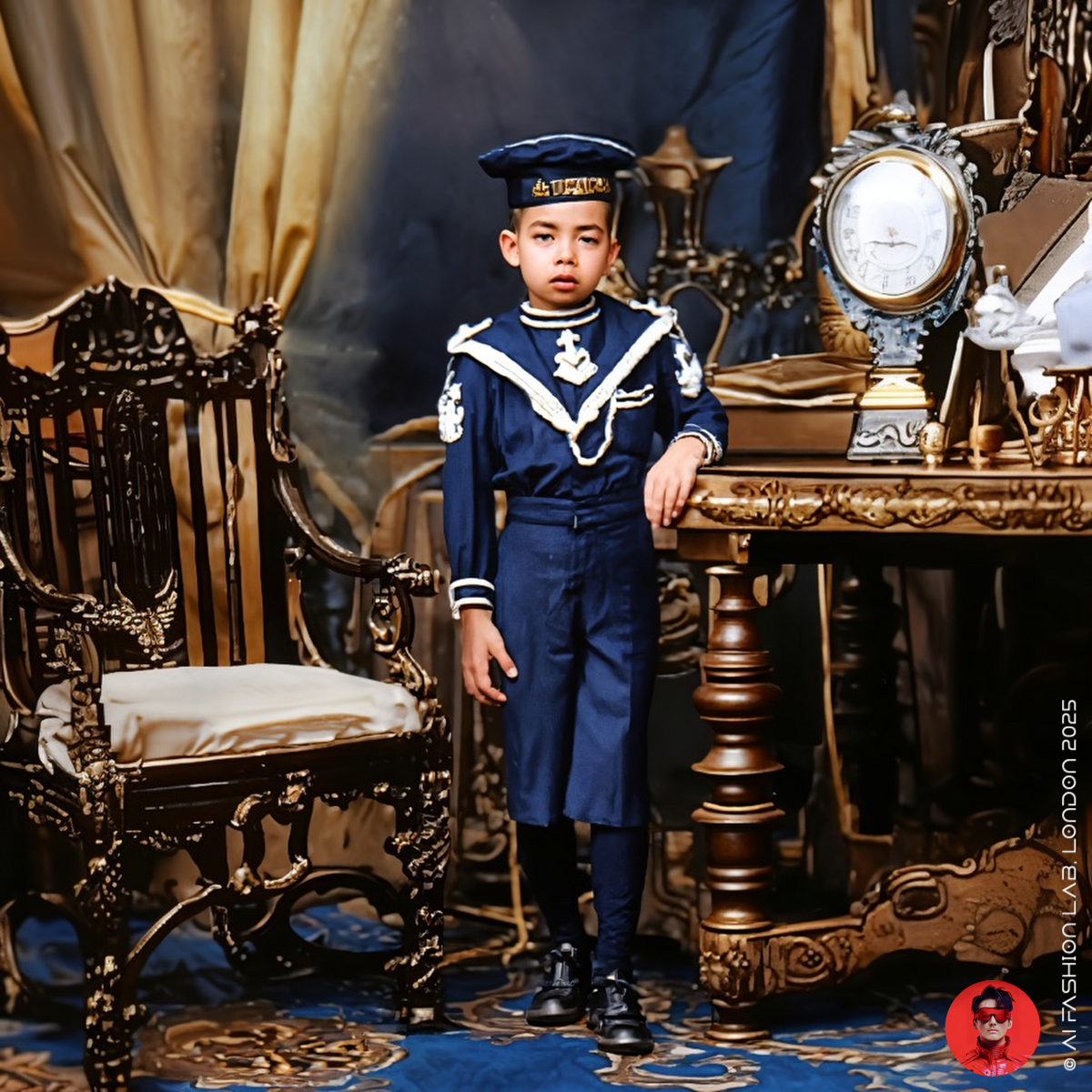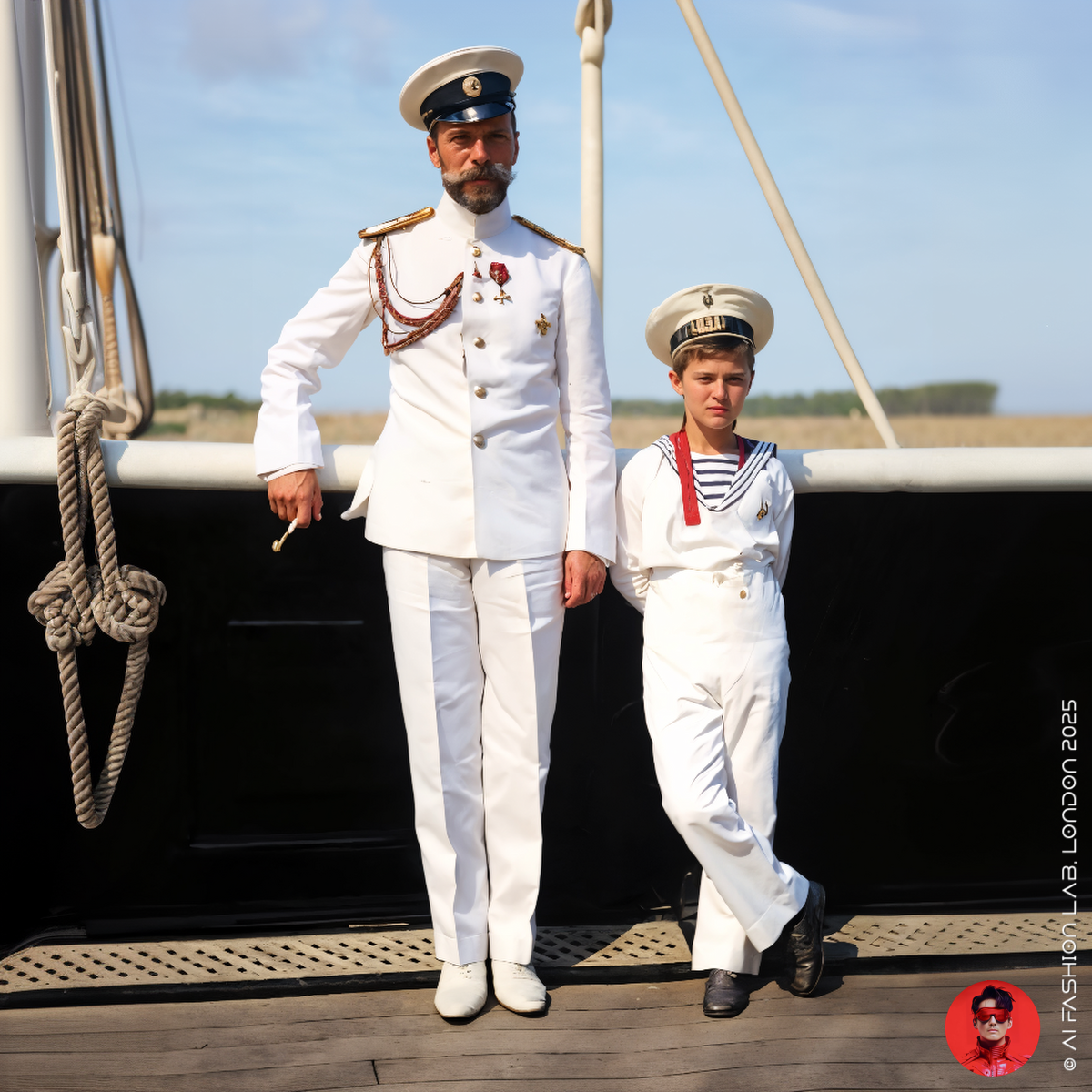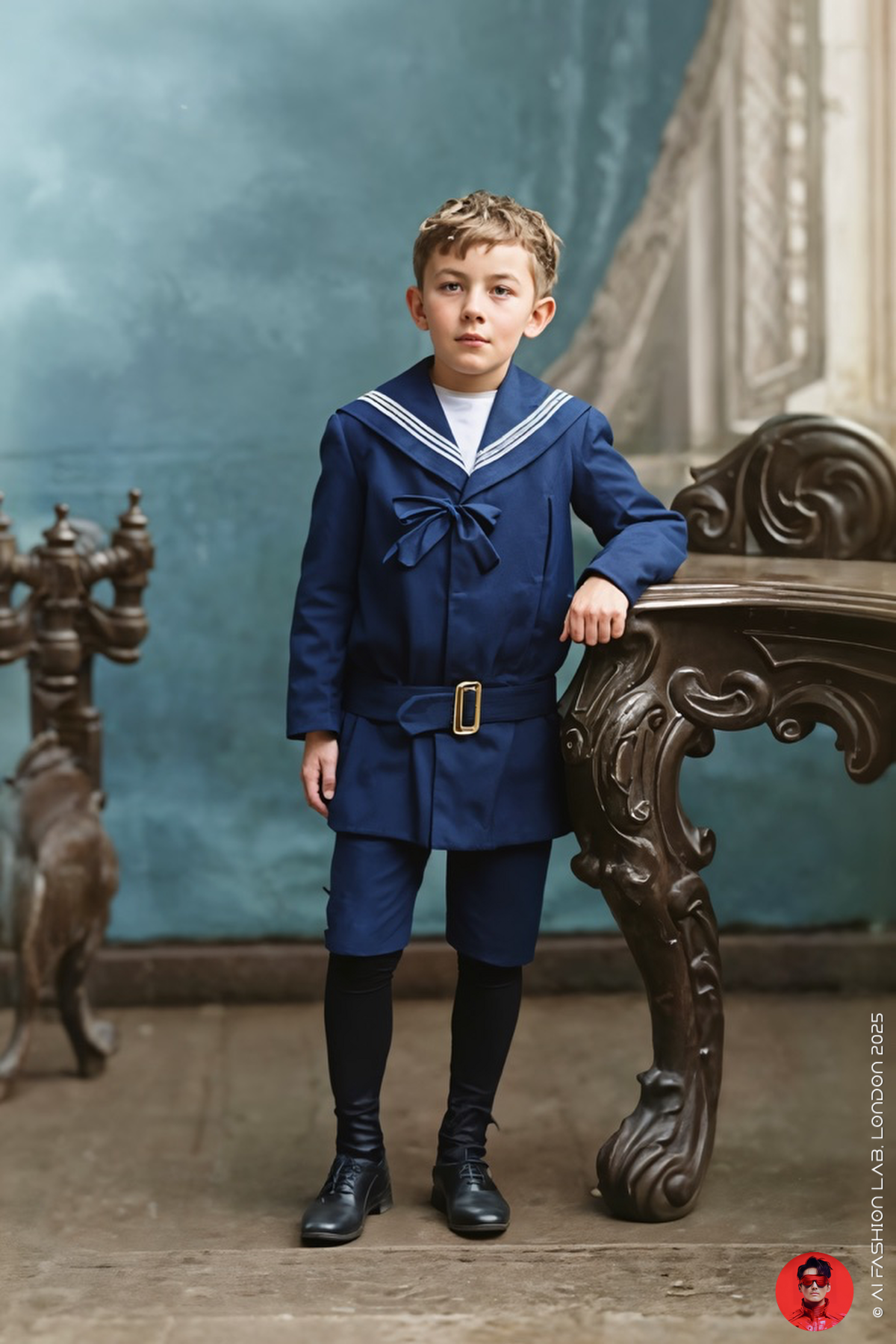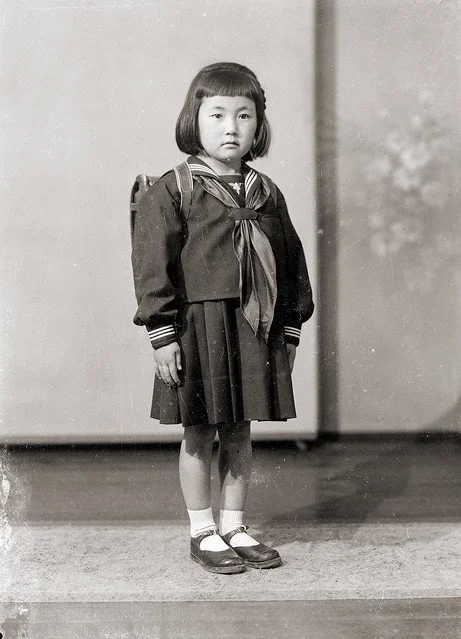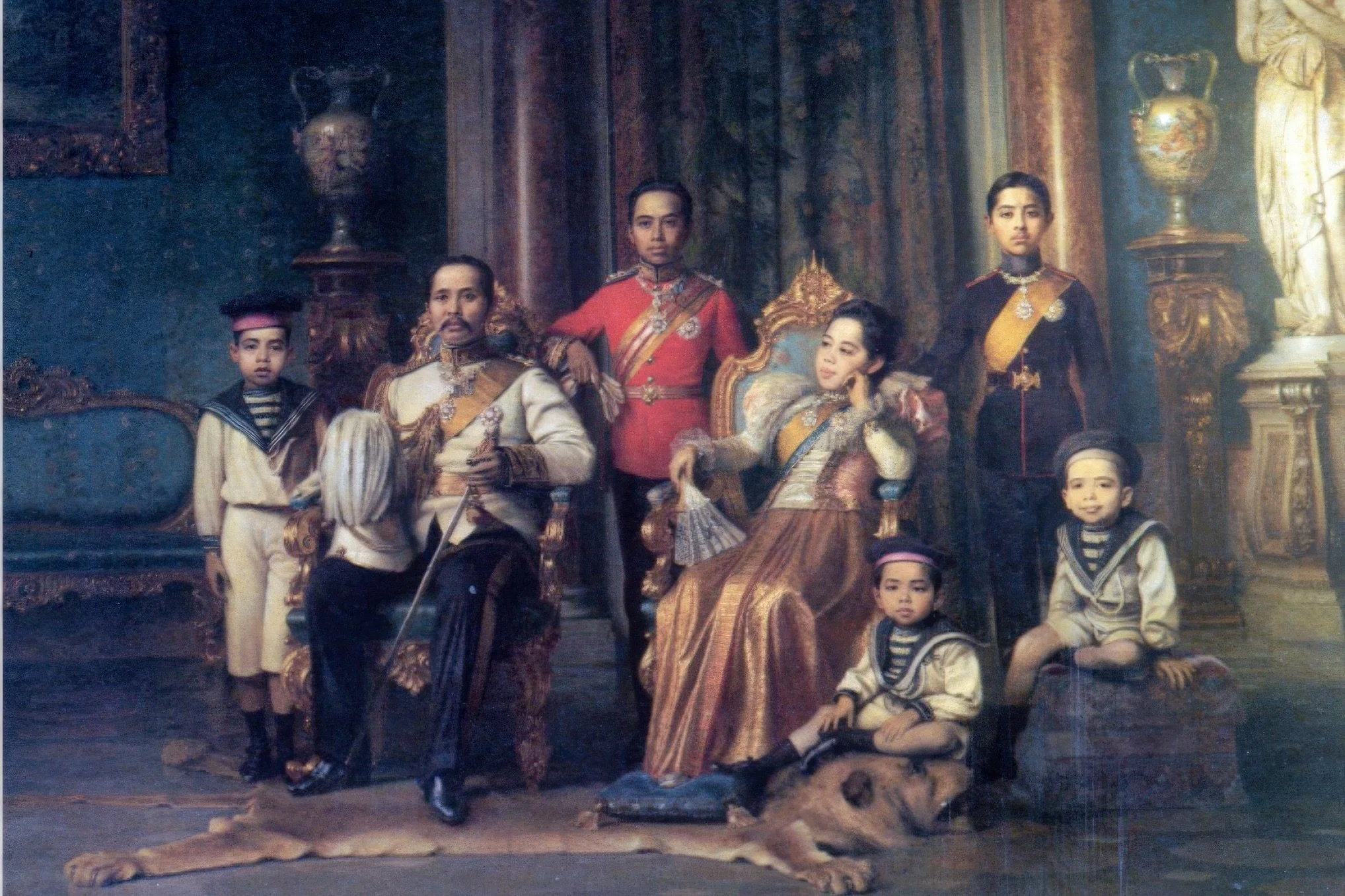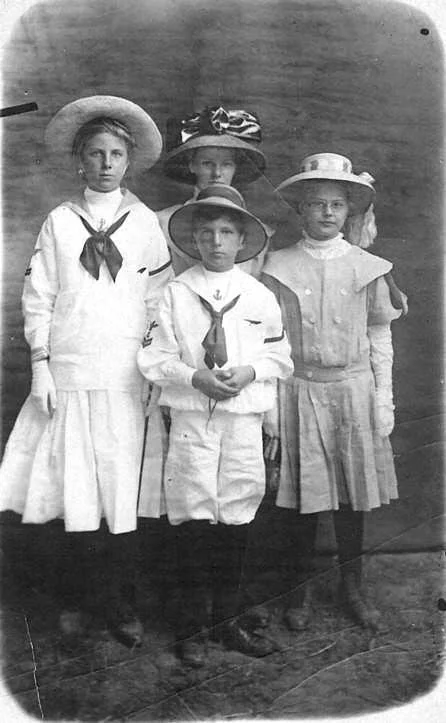ประวัติของชุดกะลาสีในแฟชั่นเด็ก: จากราชวงศ์ยุโรปสู่ราชสำนักสยาม
The Siamese Royal Family (ค.ศ. 1897–1898), จิตรกร: เอดัวร์โดเจลลี (Edoardo Gelli), เทคนิค: สีน้ำมันบนผ้าใบ ขนาด 312 × 374 ซม., สถานที่จัดแสดงเดิม: พระที่นั่งอัมพรสถาน พระราชวังดุสิต
ประวัติของชุดกะลาสีในแฟชั่นเด็ก: จากราชวงศ์ยุโรปสู่ราชสำนักสยาม
คอลเลกชันภาพนี้เป็นการลงสีใหม่ด้วย AI จากภาพถ่ายขาวดำต้นฉบับในช่วงปลายคริสต์ศตวรรษที่ 19 เพื่อฟื้นฟูและนำเสนอรายละเอียดทางแฟชั่น เครื่องแต่งกาย และค่านิยมของราชสำนักสยามในสมัยรัชกาลที่ 5 ภาพถ่ายเหล่านี้ไม่เพียงเป็นภาพประวัติศาสตร์ แต่ยังเป็นสื่อเชิงสัญลักษณ์ที่สะท้อนความเชื่อมโยงระหว่างแฟชั่นกับการสร้างอัตลักษณ์ของสถาบันพระมหากษัตริย์
จุดเริ่มต้นของชุดกะลาสีในราชสำนักอังกฤษ
ชุดกะลาสี (Sailor Suit) ที่ปรากฏในภาพนี้มีรากฐานทางประวัติศาสตร์ที่ย้อนไปถึงกลางคริสต์ศตวรรษที่ 19 ในราชสำนักอังกฤษ เมื่อ เจ้าชายอัลเบิร์ต เอ็ดเวิร์ด (Prince Albert Edward) พระราชโอรสพระองค์โตใน สมเด็จพระราชินีนาถวิกตอเรีย (Queen Victoria) และ เจ้าชายอัลเบิร์ต (Prince Consort) ทรงได้รับชุดกะลาสีจากพระบิดา ขณะมีพระชนมายุเพียง 4 พรรษา ในปี ค.ศ. 1846
พระองค์ทรงสวมชุดดังกล่าวขณะตามเสด็จพระราชมารดาไปเยือนเรือรบพระที่นั่ง HMS Victory ซึ่งเป็นเรือธงของพลเรือเอกเนลสันในยุคสงครามนโปเลียน ชุดนั้นถอดแบบมาจากเครื่องแบบของกะลาสีเรือจริงในราชนาวีอังกฤษ และการที่เจ้าชายน้อยปรากฏพระองค์ในที่สาธารณะด้วยเครื่องแต่งกายเช่นนี้ จึงกลายเป็นปรากฏการณ์ทางแฟชั่นและการเมืองในเวลาเดียวกัน
เจ้าชายอัลเบิร์ต ผู้เป็นพระบิดา ทรงมีพระประสงค์ให้แฟชั่นเป็นเครื่องมือในการปลูกฝังความรักชาติ ความผูกพันกับราชนาวี และจิตสำนึกแห่งความเป็นพลเมืองในพระราชโอรส ภาพพิมพ์หินของเจ้าชายในชุดกะลาสีจึงกลายเป็นภาพยอดนิยม และเป็นแบบอย่างให้กับแฟชั่นเด็กในราชสำนักยุโรปหลายแห่ง เช่น ออสเตรีย, ฝรั่งเศส, รัสเซีย, ญี่ปุ่น, และต่อมาคือ สยาม
การแพร่หลายสู่ยุโรปและความหมายเชิงสัญลักษณ์
หลังจากปรากฏตัวในอังกฤษ ชุดกะลาสีแพร่หลายไปยังราชวงศ์ต่าง ๆ ทั่วยุโรป โดยเฉพาะ ราชวงศ์โรมานอฟแห่งรัสเซีย ซึ่ง เจ้าชายนิโคลัสที่ 2 และพระโอรสธิดาทรงสวมชุดนี้อย่างต่อเนื่อง ภาพถ่ายเหล่านี้สร้างภาพลักษณ์ของความไร้เดียงสา ความมีระเบียบ และจริยธรรมอันสูงส่ง ตลอดจนสื่อถึงความเชื่อมโยงกับอำนาจทางทะเลและอุดมการณ์แห่งชาติ
เมื่อชุดกะลาสีเดินทางถึงสยาม: การปฏิรูปสยามในรัชกาลที่ 5
ในรัชสมัยของ พระบาทสมเด็จพระจุลจอมเกล้าเจ้าอยู่หัว (รัชกาลที่ 5, พ.ศ. 2411–2453) ประเทศสยามได้เข้าสู่กระบวนการปรับปรุงบ้านเมืองตามแบบตะวันตกอย่างเห็นได้ชัด พระองค์เสด็จประพาสยุโรป และได้นำแนวคิดใหม่ ๆ เกี่ยวกับราชประเพณี การศึกษา และการทหารกลับมาใช้ในราชสำนัก
การแต่งกายแบบยุโรป โดยเฉพาะชุดทหารเรือของพระราชโอรส จึงกลายเป็นเครื่องมือสำคัญในการแสดงความทันสมัย ความสากล และความมีศีลธรรมของราชวงศ์สยามต่อสายตาประเทศตะวันตก
การวิเคราะห์ภาพเขียน: The Siamese Royal Family (ค.ศ. 1897–1898)
จิตรกร: เอดัวร์โด เจลลี (Edoardo Gelli)
เทคนิค: สีน้ำมันบนผ้าใบ ขนาด 312 × 374 ซม.
สถานที่จัดแสดงเดิม: พระที่นั่งอัมพรสถาน พระราชวังดุสิต
ภาพเขียนขนาดใหญ่แสดงพระบาทสมเด็จพระจุลจอมเกล้าเจ้าอยู่หัว ประทับเคียงข้าง สมเด็จพระนางเจ้าเสาวภาผ่องศรี พระบรมราชินีนาถ พร้อมด้วยพระราชโอรสหลายพระองค์ซึ่งทรงฉลองพระองค์ในชุดกะลาสี
องค์ประกอบสัญลักษณ์ที่เด่นชัด ได้แก่:
ชุดกะลาสีที่คล้ายกับของเจ้าชายอังกฤษและรัสเซีย สื่อถึงความเป็นสากล
พรมหนังสิงโตและบัลลังก์แบบยุโรปที่เน้นอำนาจอธิปไตย
การจัดวางองค์แบบครอบครัวตะวันตกที่สะท้อนคุณค่าครอบครัวแบบวิกตอเรียน
บทสรุป: แฟชั่นในราชสำนักและการสร้างภาพลักษณ์สยามในสายตาชาวโลก
ชุดกะลาสีในพระบรมฉายาลักษณ์ของพระราชวงศ์สยามไม่ได้เป็นเพียงแฟชั่น แต่เป็นถ้อยแถลงทางวัฒนธรรมและการเมือง พระบาทสมเด็จพระจุลจอมเกล้าฯ ทรงใช้แฟชั่นในราชสำนัก ภาพครอบครัว และท่าทีแบบวิกตอเรียนในการนำเสนอว่า สยามเป็นชาติที่มีความศิวิไลซ์ ไม่ล้าหลัง และสมควรยืนอยู่ในระดับเดียวกับมหาอำนาจตะวันตก
ภาพที่เห็นในคอลเลกชันนี้ได้รับการลงสีด้วย AI เพื่อให้ผู้ชมยุคปัจจุบันสามารถมองเห็นรายละเอียด สีสัน และบริบทของชุดกะลาสีในราชสำนักต่างๆอย่างมีชีวิตชีวาอีกครั้ง พร้อมทั้งเป็นการเชื่อมอดีตเข้ากับปัจจุบัน ผ่านการฟื้นคืนมรดกทางวัฒนธรรมด้วยเทคโนโลยีร่วมสมัย
A History of the Sailor Suit in Children’s Fashion: From European Monarchies to the Siamese Court
This AI-enhanced collection presents colourised images based on original black-and-white royal portraits from the late 19th century. Using Generative AI, these restored visuals help bring to life the historical significance of costume, posture, and symbolic staging in the Siamese court under King Chulalongkorn. The process of colourisation not only revives historical detail but invites contemporary viewers to engage more deeply with the textures of royal modernisation and cultural diplomacy.
European Origins and Symbolic Adoption
The sailor suit as children’s wear originated in mid-19th century Britain, when Queen Victoria famously commissioned a miniature naval uniform for her son, Prince Albert Edward (the future King Edward VII), in 1846. The young prince was painted wearing the suit aboard the royal yacht Victoria and Albert, and the image soon circulated widely across Europe.
The outfit quickly became emblematic of Victorian ideals—cleanliness, order, loyalty, and patriotism—and its visual power lay in combining military structure with the innocence of childhood. Its popularity spread rapidly across royal households in Germany, Austria-Hungary, and Russia, where Tsarevich Nicholas II and, later, his own children were frequently portrayed in similar attire. These royal portraits projected images of:
Innocence and moral discipline
A connection to naval and imperial might
An alignment with Western bourgeois family values
Over time, the sailor suit evolved into a powerful symbol of childhood as a stage of moral cultivation, readiness for responsibility, and future national service.
The Arrival of the Sailor Suit in Siam
Westernisation under King Chulalongkorn
During the reign of King Chulalongkorn (Rama V, r. 1868–1910), Siam undertook a sweeping campaign of modernisation and Westernisation. Drawing on his travels across Europe and diplomatic exchanges with imperial powers, the king initiated reforms in court etiquette, military organisation, and education. Within this context, Western dress—especially for formal occasions and royal portraiture—became an instrument of diplomacy and symbolic alignment with “civilised” global monarchies.
Among these imported customs, the sailor suit emerged as a defining garment for royal children. Its adoption was highly strategic, conveying:
Modernity and Western influence
Naval awareness and internationalism
Moral and familial discipline aligned with Victorian standards
By dressing his sons in sailor suits, King Chulalongkorn presented a monarchy that was both deeply rooted in Siamese tradition and thoroughly modern—a royal family whose children were being groomed for leadership on a global stage.
Analysis of the Painting: The Siamese Royal Family (1897–98)
Artist: Edoardo Gelli
Medium: Oil on canvas (312 × 374 cm)
Original Location: Amphorn Sathan Residential Hall, Dusit Palace, Bangkok
This grand state portrait presents King Chulalongkorn seated beside his principal queen, Queen Saovabha Phongsri, surrounded by their sons—many of whom wear Western sailor suits. Commissioned in the late 1890s, the painting exemplifies how royal iconography was used to articulate Siam’s place among European monarchies.
The staging, composition, and symbolism closely emulate Victorian and Romanov family portraits.
Key Visual Motifs:
Sailor suits: Mirroring the fashion of Prince Edward and the Romanov children, the outfits highlight the princes’ Westernised education and readiness for naval or state service.
Regal posture and lion skin rug: The king and queen are enthroned in ornate European-style chairs, suggesting imperial dignity. The lion skin evokes strength, exoticism, and sovereign command.
Victorian family values: The proximity of the family, the careful symmetry, and the children’s poised appearance reflect the Western ideal of the family as the moral nucleus of national identity.
Conclusion: Western Monarchic Style and the Integration of Victorian Ideals
The sailor suit, far from being a mere trend, served as a visual code of modernity, imperial legitimacy, and dynastic unity. In both painted and photographic royal portraits of the 1890s, King Chulalongkorn carefully employed Western fashion and family iconography to broadcast Siam’s readiness to join the ranks of civilised global monarchies.
By presenting his sons in sailor suits, flanked by a European-dressed queen consort, the king projected:
Siam’s modern and reformist identity
The royal household as morally upright and emotionally cohesive
A sovereign image crafted to resist colonial narratives and assert global parity
This AI-colourised collection invites us to reconsider the importance of fashion, photography, and symbolic costuming as powerful tools in shaping national and dynastic histories.
#aifashionlab #AI #aiartist #aiart #aifashion #aifashiondesign #aifashionstyling #aifashiondesigner #fashion #fashionhistory #historyoffashion #fashionstyling #fashionphotography #digitalfashion #digitalfashiondesign #digitalcostumedesign #digitaldesign #digitalaiart #ThaiFashionHistory #ThaiFashionAI

